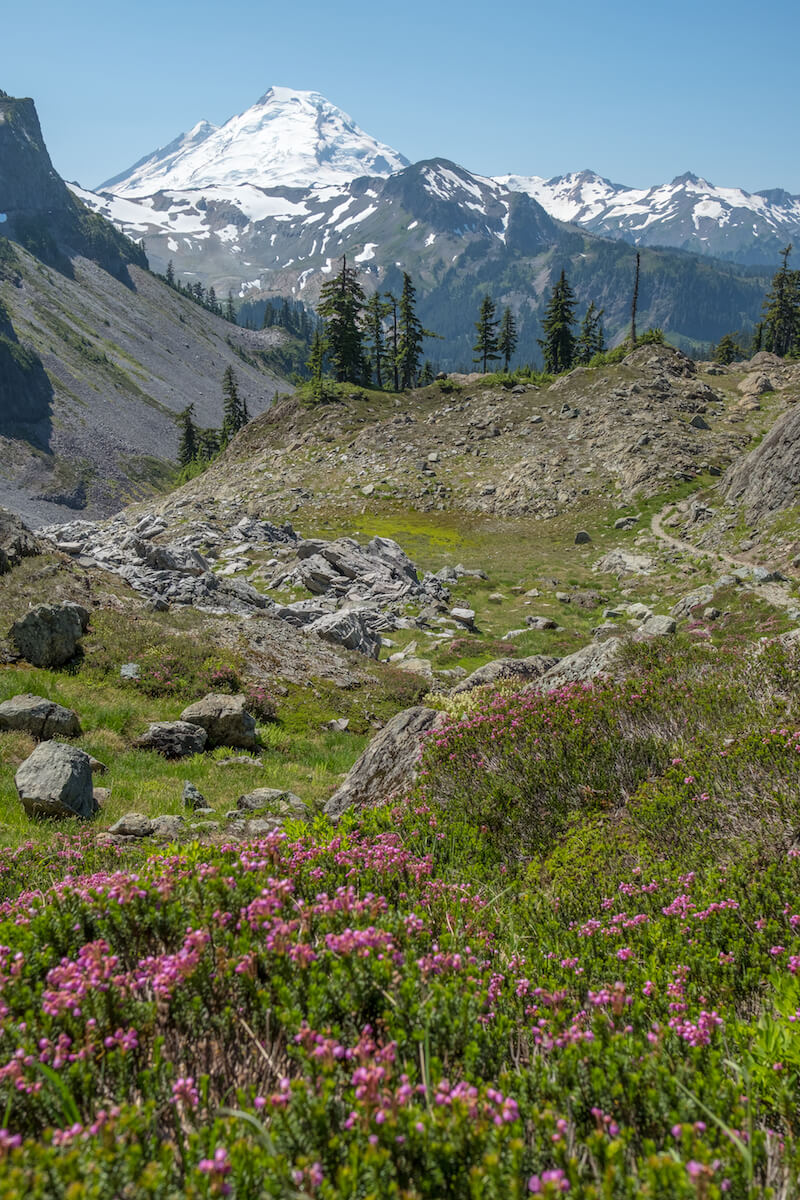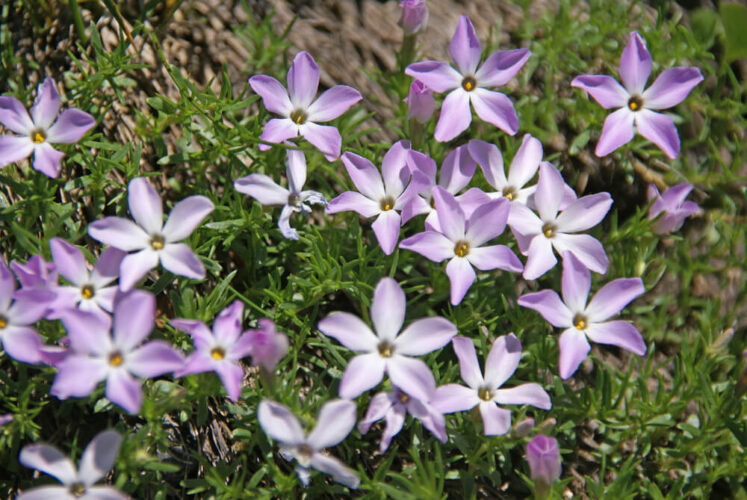Washington comes alive with a rainbow of colors with the wildflower bloom in the summer after the snow on the mountains melt.
You can find dozens of colors blanketing a meadow — if you know which wildflower hikes in Washington to look for!
Here I am sharing the prime hikes for finding Washington wildflowers across the state!
When Are the Washington Wildflowers Their Best?
The Washington wildflower season is dependent on weather and snowmelt rather than specific times of the year, but the largest window is from March through September. Each hike will have wildflowers peak at a different time within that window.
Snowmelt depends a good deal on altitude, so generally, the higher the altitude, the later in the year you’ll find beautiful wildflowers. At lower elevations, you may find some wildflowers blooming in meadows and the like as early as late March or early April.
But for alpine wildflowers, you’ll need to wait until the summer, perhaps even late summer, to allow for snowmelt!
Some national parks, such as Mt. Rainier National Park, have their own wildflower tracking pages, but for the most part, you’ll have to hike these hikes for yourself and be surprised by what Mother Nature has in store for you!
Best Wildflower Hikes in Washington
North Cascades Region
Yellow Aster Butte
This Washington wildflower hike is most colorful during the late summer, when you will find fiery meadows of oranges, reds, and yellows.
The trail climbs steeply through the forest before arriving in the meadow – where you will first find the flowers. From here, the trail continues through the wildflower-filled meadows for a few miles, making the length of the trip adjustable for your needs.
In addition to the wildflowers, this hike also features spectacular views of Mt Baker, the High Divide, and even Canada.
Pro Tip: Camping along this trail, although popular, offer stunning views of the sunset over the wildflower meadows. Arrive early in the day to secure a spot in one of the established campsites. Avoid camping on the fragile meadows.

Some links in this post may be affiliate links. If you make a purchase through one of these links, we may earn a small commission at no extra cost to you. Please see our disclosure policy for more detail.
Chain Lakes Loop
This trail wanders through a chain of lakes – as its name implies – in the spectacular high alpine region near Mt Baker.
At the peak of summer, when the weather is the most beautiful, and the snow is all melted, this trail also lights up with a grand variety of wildflowers.
Find the perfect timing, and you may find an abundance of huckleberries ripe for picking along the trail as well.
This moderately difficult hike is a great choice for those who have most of a day available for a Washington wildflower hike with alpine views and lakes.

Sauk Mountain
The meadows start almost as soon as you leave the parking lot on this hike. With views the whole way up, and flower species that change with your elevation, it is impossible to get bored on this hike.
You will start by seeing daisies and flowering thistles near the parking lot, which will transition into penstemon, paintbrush, bluebell, and almost un-ending other varieties as you ascend to the top of Sauk Mountain.

Heather – Maple Pass Loop
A favorite in any season, this hike also shines during the summer wildflower bloom.
Hiking the loop clockwise, you will ascend through the trees – where if you’re lucky, you may spot some of the elusive trillium or other forest flowers – before arriving at Lake Ann.
As you continue, the woods will give way to meadows and the never-ending sea of North Cascades peaks.
This trail is loved for its ridgeline paths that gives you full views of the surrounding peaks that will draw your eyes away from the wildflower meadows; but if you can manage to look down, you will find an astounding number of wildflowers lining the hills.

Green Mountain
Green Mountain is named after its most apparent feature – the bright green, treeless meadows that span the upper slopes of this mountain in springtime.
Although the green is visible from a distance, what you can’t see from a distance is the multitude of wildflowers that grow on these meadows in summer.
This challenging hike with a rough approach road is well-worth the trek, with a marmot nicknamed “The Greeter” who lives near the summit, and an old lookout that remains at the top!

Mt Dickerman
The hike to the top of Mt Dickerman is a strenuous day hike for most hikers, but the effort is worth the reward for those who make it to the top.
This hike begins in the forest and doesn’t make it to meadows until halfway up. However, when you find the meadows, they are full of multicolored mountain flowers.
In addition to the flowers, the views at the summit are some of the best in the region.

Central/South Cascades
Kendall Katwalk
This trail is most famous for its narrow path along the side of a rocky cliffside. The path to this location is however also lined with alpine wildflowers.
This trail, part of the Pacific Crest Trail near Snoqualmie Pass, is wide and well-graded, helping to ease the elevation gain up to this stunning view, although the talus switchbacks do make it a bit of a challenge.
If you miss the peak of wildflower season here, you will find the peak of huckleberry season – providing a welcome distraction from the climbing trail and the steep cliffs.

Heybrook Ridge
Another well-crafted trail offers a pleasant walking experience featuring an abundance of wildflowers.
Along the way to the ridge, you will find foxglove, bear grass, and possibly trillium if you are lucky.
In contrast to many of the other hikes in this list, this hike spends less time in the high alpine and more time in the old growth forest.
Nonetheless, the flowers on this hike make a great hike, and the location along Highway 2 and proximity to Seattle makes this a more accessible day trip for many and a great wildflower hike near Seattle.

Ira Spring Trail to Mason Lake
A moderate difficulty hike near Snoqualmie Pass, this trail traverses alpine rock fields and meadows before reaching Mason Lake.
Along the way, the trail features an abundance of flowers, which make for a welcome distraction from the grueling switchbacks.
Stay left at the junction with the Bandera Mountain Trail to head towards Mason Lake – a great place for an afternoon nap along the lakeshore or an overnight stay at one of the campsites. The trail up Bandera Mountain offers more views but is a very strenuous scramble to the top for seasoned hikers.

Spray Park
One of the less popular areas within Mt Rainier National Park, due to the long drive on a sometimes-rough road, a visit to Spray Park will reward you with (relative) solitude and an abundance of wildflowers.
The trail starts with switchbacks before reaching the meadows – where the real wildflower show begins.
There is a network of trails once you reach the meadows letting you choose your own path through this gorgeous region.

Naches Peak Loop
A high mountain trail within Mt Rainier National Park, this trail is another hike you can’t miss during wildflower season!
The trail begins at Tipsoo Lake (when the loop is hiked clockwise, as recommended), circles around Naches Peak past Dewey Lake, then meets the PCT before returning to Tipsoo Lake.
The peak wildflower section of this trail comes in the alpine meadows right near the end – so if you are only looking for wildflowers, the hike could be shortened.
However, the rest of the hike offers plenty of wildflowers as well, and stunning views of Mt Rainier, so if you have the time, it is not to be missed.

Other Wildflower Hikes in Washington
Ancient Lakes
Located in Central Washington, this hike has very different varieties of wildflowers than you’ll find on the high alpine hikes in this list.
The canyon environment here is awesome, and even if you miss wildflower season, you’ll be able to explore the rock formations and canyons of this region.
The trail here is lined with sagebrush and sand, but look closely, and you might be surprised at the variety of flowers that live in this dry environment.

Esmeralda Basin
This is a moderate hike through the Esmerelda Peak range of the Teanaways – the region on the east side of Snoqualmie Pass.
This trail on the east side of the mountains has thinner trees, meaning the wildflowers here are even more spectacular as many of the most colorful flower species prefer lots of light.
According to the trail description on WTA.org, this trail has over 75 species of wildflowers!
When you aren’t busy looking at all these varieties of wildflowers, this trail also features old mining operations and views from Fortune Creek Pass.

Dog Mountain
Such a popular hike that it now requires a permit to hike, Dog Mountain is one of the most loved hikes within the Columbia River Gorge region.
If you plan ahead and manage a permit though, the extra effort will be well worth it in the springtime, when the trail is lined with wildflowers.
Along the way, make sure to stop and admire the view of the Columbia River from the spot known as “puppy dog lookout.”
The flower that will most catch your eye when you arrive at the top of Dog Mountain is yellow balsamroot, a brilliant yellow flower that covers the meadows here.

Hurricane Hill
A classic hike in Olympic National Park, Hurricane Hill is best known for its views. Don’t let that fool you. Although most hikers may forget to look for the flowers, the trail features many beautiful wildflowers along the way.
From the top, there are views of Puget Sound, the Olympic Mountains, and into Canada.
Another great feature of this trail is that it is paved and wide, making it accessible to a greater number of visitors.




